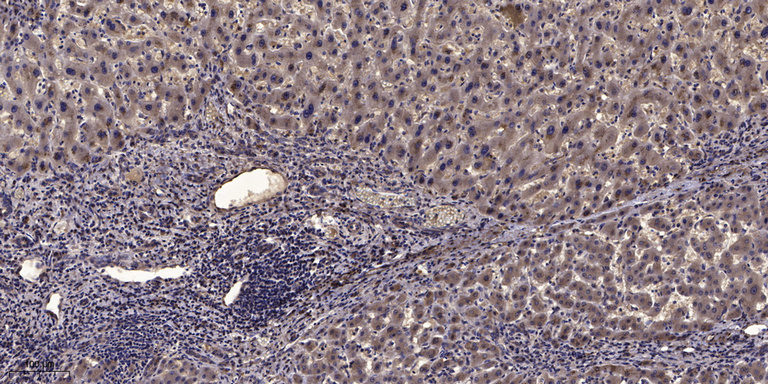Myosin IIa (Phospho Ser1943) rabbit pAb
- Catalog No.:YP1408
- Applications:WB;IHC
- Reactivity:Human;Rat;Mouse;
- Target:
- Myosin IIa
- Fields:
- >>Vascular smooth muscle contraction;>>Tight junction;>>Regulation of actin cytoskeleton;>>Pathogenic Escherichia coli infection
- Gene Name:
- MYH9
- Protein Name:
- Myosin IIa (Ser1943)
- Human Gene Id:
- 4627
- Human Swiss Prot No:
- P35579
- Mouse Gene Id:
- 17886
- Mouse Swiss Prot No:
- Q8VDD5
- Rat Gene Id:
- 25745
- Rat Swiss Prot No:
- Q62812
- Immunogen:
- Synthesized phosho peptide around human Myosin IIa (Ser1943)
- Specificity:
- This antibody detects endogenous levels of Human Myosin IIa (phospho-Ser1943)
- Formulation:
- Liquid in PBS containing 50% glycerol, 0.5% BSA and 0.02% sodium azide.
- Source:
- Polyclonal, Rabbit,IgG
- Dilution:
- WB 1:500-2000;IHC 1:50-300
- Purification:
- The antibody was affinity-purified from rabbit serum by affinity-chromatography using specific immunogen.
- Concentration:
- 1 mg/ml
- Storage Stability:
- -15°C to -25°C/1 year(Do not lower than -25°C)
- Other Name:
- Myosin-9 (Cellular myosin heavy chain, type A) (Myosin heavy chain 9) (Myosin heavy chain, non-muscle IIa) (Non-muscle myosin heavy chain A) (NMMHC-A) (Non-muscle myosin heavy chain IIa) (NMMHC II-a) (NMMHC-IIA)
- Observed Band(KD):
- 215kD
- Background:
- This gene encodes a conventional non-muscle myosin; this protein should not be confused with the unconventional myosin-9a or 9b (MYO9A or MYO9B). The encoded protein is a myosin IIA heavy chain that contains an IQ domain and a myosin head-like domain which is involved in several important functions, including cytokinesis, cell motility and maintenance of cell shape. Defects in this gene have been associated with non-syndromic sensorineural deafness autosomal dominant type 17, Epstein syndrome, Alport syndrome with macrothrombocytopenia, Sebastian syndrome, Fechtner syndrome and macrothrombocytopenia with progressive sensorineural deafness. [provided by RefSeq, Dec 2011],
- Function:
- disease:Defects in MYH9 are the cause of Alport syndrome with macrothrombocytopenia (APSM) [MIM:153650]. APSM is an autosomal dominant disorder characterized by the association of ocular lesions, sensorineural hearing loss and nephritis (Alport syndrome) with platelet defects.,disease:Defects in MYH9 are the cause of Epstein syndrome (EPS) [MIM:153650]. EPS is an autosomal dominant disorder characterized by the association of macrothrombocytopathy, sensorineural hearing loss and nephritis.,disease:Defects in MYH9 are the cause of Fechtner syndrome (FTNS) [MIM:153640]. FTNS is an autosomal dominant macrothrombocytopenia characterized by thrombocytopenia, giant platelets and leukocyte inclusions that are small and poorly organized. Additionally, FTNS is distinguished by Alport-like clinical features of sensorineural deafness, cataracts and nephritis.,disease:Defects in MYH9 are the cause o
- Subcellular Location:
- Cytoplasm, cytoskeleton . Cytoplasm, cell cortex . Cytoplasmic vesicle, secretory vesicle, Cortical granule . Colocalizes with actin filaments at lamellipodia margins and at the leading edge of migrating cells (PubMed:20052411). In retinal pigment epithelial cells, predominantly localized to stress fiber-like structures with some localization to cytoplasmic puncta (PubMed:27331610). .
- Expression:
- In the kidney, expressed in the glomeruli. Also expressed in leukocytes.
- June 19-2018
- WESTERN IMMUNOBLOTTING PROTOCOL
- June 19-2018
- IMMUNOHISTOCHEMISTRY-PARAFFIN PROTOCOL
- June 19-2018
- IMMUNOFLUORESCENCE PROTOCOL
- September 08-2020
- FLOW-CYTOMEYRT-PROTOCOL
- May 20-2022
- Cell-Based ELISA│解您多样本WB检测之困扰
- July 13-2018
- CELL-BASED-ELISA-PROTOCOL-FOR-ACETYL-PROTEIN
- July 13-2018
- CELL-BASED-ELISA-PROTOCOL-FOR-PHOSPHO-PROTEIN
- July 13-2018
- Antibody-FAQs
- Products Images

- Immunohistochemical analysis of paraffin-embedded human liver cancer. 1, Antibody was diluted at 1:200(4° overnight). 2, Tris-EDTA,pH9.0 was used for antigen retrieval. 3,Secondary antibody was diluted at 1:200(room temperature, 45min).



